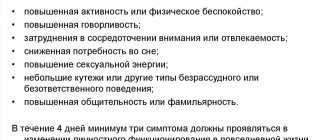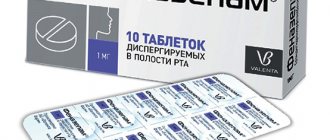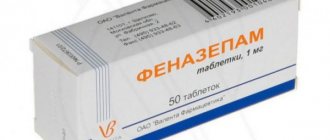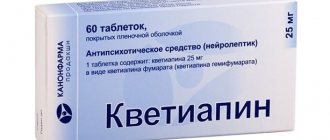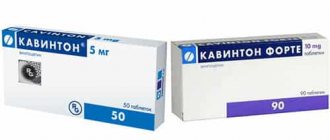Treatment with lithium salts is carried out under the control of its content in the blood plasma. The therapeutic effect of lithium salts is realized in the presence of a certain amount of the drug in the blood. The concentration of lithium in the blood at which the preventive effect occurs is 0.5-0.8 mmol/l. When treating manic states, the concentration of the drug in the blood should be higher and averages 0.8-1.2 mmol/l, but should not exceed 1.5 mmol/l [Avrutsky G.Ya., Neduva A.A., 1988 ].
Continued below
⇓
General characteristics of mood stabilizers
... schizoaffective attacks in patients with affective disorders, schizoaffective psychosis and paroxysmal schizophrenia.
Normotimics
or thymoisoleptics include drugs that regulate affective (circular) disorders and provide secondary preventive ...
Read more…
everything on this topic
For a preventive course, lithium carbonate is prescribed starting from 0.3-0.6 g/day, then the dose is increased to 0.9-1.2 g/day (3-4 tablets per day). Care should be taken to ensure that the concentration of the drug in the blood is within the range of 0.5-0.8 mmol/l. As the concentration increases, the dose of the drug should be reduced and a dosage selected that will correspond to the required concentration of lithium in the blood plasma. Elderly people, due to a decrease in the level of glomerular filtration, require significantly lower doses to achieve the required concentration of the drug than young people. In this case, the concentration of lithium in the blood should be in the range of 0.3-0.4 mmol/l.
When relieving manic states, the dose of lithium carbonate should be higher and can be 1.5-2.1 g/day, and sometimes 2.4 g/day, and the concentration of the drug in the blood is within 0.8-1.2 mmol/l . If the concentration of lithium in the blood is not determined, the administration of high doses of the drug is contraindicated. After stopping the manic state, the daily dose is gradually reduced to the preventive level.
When selecting a dose of the drug, determination of the concentration of lithium in the blood should be carried out weekly, then once a month, and subsequently once every 2-3 months. If the concentration of lithium in the blood changes upward or downward, adjustment of the dosages used is necessary. Lithium carbonate is administered orally after meals to reduce its irritant effect on the gastric mucosa.
Mood stabilizers: list of drugs for mood stabilization
A group of pharmacological drugs - Normotimics (or thymoisoleptics) - drugs that stabilize human mood, belonging to the class of psychotropics.
Doctors prescribe mood stabilizers to stabilize mood, for example, in the manic or depressive phase of bipolar affective disorder.
Normotimic drugs also help people without mental pathology, not sick, for example, with neuroses, borderline states or pronounced character accentuation (cycloid, exalted, epileptoid, etc.)
Those. with severe aggressiveness, irritability, quarrelsomeness, short temper and painfully low mood (dysphoria)…
List of major mental and nervous diseases for which psychiatrists prescribe mood stabilizers (normalizers, mood stabilizers):
- Schizophrenic disorders and diseases (Schizophrenia as a disease or schizoaffective disorder)
- Bipolar affective disorder (old. Manic-depressive psychosis)
- Cyclothymic disorder (Cyclothymia or cycloid accentuation - frequent cyclical impulsive mood changes without obvious stimuli)
- Dysthymia (Depressive mood disorder)
- Recurrent depression (unlike ordinary major depression, recurrent depression occurs episodically, with mood swings)
- Epileptic disorders (epilepsy is more related to neurology than to psychiatry)
Attention! Psychotropic drugs for mood stabilization - mood stabilizers - can be taken only as prescribed by the attending physician and under his supervision.
Under no circumstances should you use mood-timing medications just because you are in a bad mood today.
Normotimics - list of drugs
Psychotropic drugs - mood stabilizers - may include the following active substances: Lithium salts, Rubidium Chloride, Cesium Chloride, Lamotrigine, Carbamazepine, Valproate, etc.
The main list of mood-timing drugs used in our country to normalize mood.
- Valparin
- Convulex
- Convulsofin-retard
- Actinerval
- Zeptol
- Finlepsin
- Seroquel
Thymoisoleptics - mood stabilizers of a new generation
The new generation of mood stabilizers - Thymoisoleptics - are more effective mood stabilizers with fewer side effects and relapses.
The main normothimic drugs of the new generation:
- Cyclodol
- Sedalite (Lithium carbonate)
- Lamotrigine
Contraindications, side effects and patient reviews
Motility medications, like all psychotropic drugs, have many contraindications and even more side effects.
Contraindications:
- Kidney and liver failure
- Pancreatitis in the acute phase
- Heart diseases
- BPH
- Hypotension (low blood pressure)
Side effects:
- Nausea, sometimes vomiting
- Trembling in arms and legs
- Dry mouth
- Muscle weakness
- Problems with appetite and digestion
- Increased sleepiness
- Psychosomatic and neurological symptoms
- Slowness of movement, loss of strength and decreased performance
Feedback from patients after taking mood stabilizers The majority of independently surveyed people with sudden mood swings who were prescribed Normotimics medications complained of a large number of side effects - both mental and physical.
And although they came out of the extreme affective phases of mania (euphoria) or depression (dysphoria), others showed a decrease in aggression and irritability, but in the usual understanding of the concept of “Mood” it was far from being at its best.
If you do not have a psychotic disorder, but simply a character neurosis...
If you do not have a mental pathology, which is the competence of psychiatrists, but your mood often “jumps” from one polarity to another for a long time - perhaps a neurotic, borderline disorder or character neurosis (pronounced accentuation), then you do not need mood stabilizers as stabilizers moods.
You can not only raise your mood, normalize it and stabilize it without psychotropic mood stabilizers, but also get rid of the internal root cause of its fluctuations.
For mild emotional disorders and neuroses of character, expressed by its accentuations, various psychotrainings and exercises help.
In more complex cases, drug-free psychotherapy and psychoanalysis will help.
Lamotrigine
This drug is used in different phases of bipolar disorder and for maintenance therapy for this disease. Lamotrigine may be used to enhance antidepressant therapy for treatment-resistant depression (depression that is resistant to an adequate course of antidepressant therapy).
Lamotrigine is usually well tolerated by patients: it is less likely than other mood stabilizers to cause weight gain and lethargy. Other side effects when taking lamotrigine:
- rash;
- dizziness and headache;
- double vision.
In any case, we remind you that discontinuation of the drug, even due to side effects, should be done after consultation with a doctor, and not arbitrarily.
Mood stabilizers (mood stabilizers): list of drugs, indications for use, side effects
The purpose of taking mood stabilizers is to stabilize mood.
These drugs should not be prescribed to yourself, otherwise the situation may worsen. It is important to learn about the mechanism of action and side effects before taking them.
Mechanism of action of mood stabilizers
Normotimics belong to the group of psychotropic drugs.
Based on research, the following mechanisms of their impact have been identified:
- decreased neuronal signal transmission;
- suppression of adenylate cyclase concentration;
- activation of the cholinergic system.
Thus, mood stabilizers have the following effects on the body:
- reduce irritability;
- stop impulsiveness;
- reduce temper;
- remove the feeling of hostility towards others;
- normalize the sleep-wake cycle.
Indications for use and classification
The general goal of mood stabilizers is to normalize mood. They are actively used in psychiatry and prescribed for the treatment of affective disorders.
These include:
Often, mood stabilizers are prescribed for mental disorders if the disease is accompanied by irascibility, impulsivity, irritability and aggression. They are able to smooth out such manifestations.
Normotimics are classified into the following categories:
- Lithium preparations . Used to treat manic states. They normalize mental balance and the function of sodium channels.
- Carbamazepine derivatives . They are used for exacerbation of affective states more than four times a year, depression, mania, and schizophrenia.
- Lamotrigine and drugs based on it . Initially created for patients with epilepsy. They have side effects such as allergies, damage to the nervous system, and intestinal disorders.
- Valproate . Prescribed for bipolar disorder and chronic low mood. Drugs in this group inhibit neurotransmitters.
Sometimes mood stabilizers are prescribed for infrequent relapses of psychosis.
List of drugs
There are many mood stabilizers sold through the pharmacy chain, which differ in the main active ingredient. Let's look at some drugs, a list of the best of them is presented below.
- Valparin
Used for the treatment of epilepsy of various origins, in the complex therapy of manic-depressive states. Tablets are taken two to three times a day during or after meals. During therapy, alcoholic drinks are prohibited and a diet is recommended due to the risk of weight gain.
- Convulex
Indications for use of Konvulex: organic brain diseases, behavioral disorders, febrile seizures. The dosage is prescribed individually for each patient. Usually 10-15 mg per kilogram of weight per day is prescribed, followed by an increase. Frequency of administration: two to three times a day. Side effects from the digestive system are possible in the form of diarrhea, nausea, constipation.
- Convulsofin-retard
A popular drug for the treatment and prevention of bipolar disorders is based on valproic acid. It is prohibited for children under six years of age to take it. The average daily dose for an adult is 20 mg per day per kilogram of body weight.
Normotimik is used to prevent attacks in alcohol withdrawal syndrome and affective psychoses. The doctor determines the frequency of administration individually. The starting dose for adults is 100 to 400 mg.
- Zeptol
The active substance is carbamazepine. Zeptol is taken 200 mg twice a day with a gradual increase in dosage. The duration of the course is determined by the attending doctor. Contraindicated in children under 5 years of age.
- Finlepsin
The tablets have antipsychotic, antiepileptic and analgesic effects. It is used to relieve seizures of various origins and treat mental disorders that are accompanied by increased anxiety. Initial and maintenance dosage is from 200 to 400 mg per day.
- Seroquel
It is an antipsychotic drug that is recommended for acute and chronic psychoses, including schizophrenia. The active ingredient is quetiapine.
The dosage of Seroquel, as a mood stabilizer, is 50 mg per day in adults and 25 mg for older people. Afterwards the quantity is increased according to the scheme.
The exact dosage is calculated based on the clinical effect and individual sensitivity of the patient.
Some of the drugs on this list are not available without a doctor's prescription. For example, Seroquel, Convulex.
- Cyclodol
An antiparkinsonian drug helps eliminate movement disorders. The initial dose is from 0.5 to 1 mg per day. Side effects from the central nervous system are possible in the form of headaches and irritability.
- Lithium carbonate
Lithium carbonate is used for manic episodes, hypomania, alcohol dependence syndrome and other mental problems. The drug is not compatible with ethanol-containing drinks. In combination with antipsychotics and antidepressants, body weight may increase. The dosage is prescribed based on the concentration of lithium in the blood. Typically it ranges from 900 to 2400 mg per dose. The dose is divided into 3-4 doses.
- Lamotrigine
The antiepileptic drug Lamotrigine inhibits the release of glutamic acid. It is prescribed for the treatment of seizures in Lennox-Gastaut syndrome, as a prophylactic drug for depression and various manias. The daily dosage ranges from 100 to 200 mg.
Mikalit
The drug mikalit
is a prolonged dosage form containing microcapsules with lithium carbonate (0.4 g of the drug). One capsule contains 80% lithium carbonate and 20% cellulose acetate. Compared to lithium carbonate, the drug creates a longer and more stable concentration of lithium in the blood. Mikalit is prescribed orally after meals. To relieve a manic state, 2 capsules per day are usually prescribed in one or two doses; if necessary, the dose is increased to 4-5 capsules per day under monitoring the concentration of lithium in the blood. For preventive purposes, micalite is prescribed 1-2 capsules per day [Mashkovsky M.D., 1993].
Mood stabilizers: indications for use, list of drugs for mood stabilization
An indication for the use of mood stabilizers is the presence within three years of two or more attacks of exacerbation of an affective or affective-delusional state within the categories listed below:
- schizoaffective disorder;
- bipolar affective state;
- long-term recurrent depression;
- chronic mood disorder;
- cyclothymia.
Regulatory drugs have the following properties:
- eliminate serious causes;
- relieve irritability;
- stop short temper;
- eliminate impulsiveness;
- relieve symptoms of dysphoria in patients with mental disorders.
Therapeutic effect
Normotimics are prescribed for the treatment of affective states and for the purpose of prevention in case of minor relapses of affective psychoses. Most of this group of drugs are considered anticonvulsants.
Thymoisoleptics are now increasingly used to improve mood. Initially, they were used only in the treatment of epilepsy to relieve seizures.
Further, this group of drugs began to be used to treat affective states, long-term depression, to equalize and stabilize mood and reduce sharp edges during communication when the patient has a difficult temperament.
Long-term treatment helps reduce the risk of relapse while normalizing mood swings.
Mechanism and features of the effect
There is no reliable data on how mood stabilizers work. Based on the research conducted so far, the following results were obtained:
- the main cellular mechanisms that are triggered under the influence of thymoisoleptics have been identified;
- lithium reduces neuronal signal transmission, thereby increasing mood;
- the concentration of adenylate and cyclase is suppressed;
- The main task of this group of drugs is to stabilize mood and eliminate the causes of the affective state.
Features and precautions for use
Treatment with mood stabilizers should be carried out under the strict supervision of medical personnel and the concentration of the active substance in the blood should be regularly checked. If its content is increased, the side effects of mood stabilizers may worsen.
Medicines in this group should be used with caution if the patient has a history of:
- disturbance of heart rhythm and conduction;
- severe pathology of the liver and kidneys;
- blood and bone marrow diseases;
- predisposition to allergies;
- prostatitis;
- drugs are contraindicated during pregnancy and breastfeeding;
- hypersensitivity to drug components;
- acute pancreatitis;
- at reduced pressure.
With long-term treatment with mood stabilizers, you need to:
- monitor the general condition of the patient;
- once a month donate blood for biochemistry, clinical blood and urine tests;
- ECG.
Classification of drugs
According to the modern classification, mood stabilizers include 4 groups of drugs:
- lithium salts, this includes lithium carbonate, long-acting lithium products;
- Carbamazepine derivatives;
- valproates and derivatives;
- Lamotrigine and products based on it.
Lithium salts
Indications for use:
- hereditary predisposition to affective disorders;
- slight severity of negative symptoms;
- a clear picture of an attack;
- bipolar form of affective disorder;
- manic syndrome;
- rhythm throughout the day.
For a long time, this group of drugs has been prescribed to eliminate the above conditions. The drugs are used to treat and prevent diseases.
Lithium preparations have been studied quite well and provide a positive therapeutic effect. During the period of taking lithium salts, it is necessary to maintain strict medical control and monitor the concentration of the drug in the blood. If its content is significant, side effects from taking the drug may increase.
Side effects:
- hand tremors;
- thirst;
- muscle weakness;
- drowsiness;
- nausea.
Carbamazepine derivatives
Indications for use:
- exacerbations of affective states more than 4 times a year;
- resistance to lithium salts;
- schizoaffective disorders;
- depression;
- various manias.
- first episodes of the disease.
At first, carbamazepine and its analogues were used to eliminate seizures in trigeminal neuralgia.
Then, after numerous studies, positive dynamics were identified in the treatment of affective states, frequent mood swings, and alcoholism. When treating with carbamazepine derivatives, you need to regularly monitor the concentration of the drug in the blood.
Please note that Carbamazepine:
- reduces concentration;
- simultaneous use of hormonal drugs is not possible;
- reduces the effectiveness of coagulants.
Fluoxetine - improves mood - Mood-lifting medications
Depression causes a depressed mood, lack of interest in life, sleep disturbances, obsessive thoughts of unpleasant content, and a feeling of inferiority.
Fluoxetine has a moderate stimulating effect, causes a decrease in appetite, can lead to weight loss, improves mood, and reduces feelings of fear and tension.
Used in the treatment of depression, does not cause a calming effect.
Mood pills are antidepressants or psychotropic drugs that act on the central nervous system. Persen is a drug made from herbal ingredients that acts as a sedative.
Don’t forget about medicinal plants, which are better than any pills in calming the nervous system and improving mood.
Tincture of hawthorn, calendula and medicinal angelica - have a sedative effect and are considered natural relaxants.
Vitamins that improve mood are used to strengthen the nervous system and improve psycho-emotional state. Vitamin B deficiency disrupts overall health, causes irritability, increased drowsiness and reduces body tone.
Thiamine is a vitamin of good spirits, used for psycho-emotional disorders, stimulates the functioning of the nervous and cardiovascular systems.
The drug stimulates mental activity, increases performance, relieves fatigue and maintains a good mood.
Carbamazepine
Carbamazepine is widely loved by neurologists, psychiatrists and narcologists. Various neuralgia, bipolar disorder, mood disorders due to damage to the central nervous system, alcohol dependence and withdrawal syndrome, and so on and so forth. Carbamazepine is dear to the hearts of many specialists and is prescribed for a wide variety of conditions. It should be taken into account that carbamazepine reduces the concentration of antipsychotics (neuroleptics) and antidepressants in the patient’s blood, which can lead to a worsening of the condition when carbamazepine is added. Like other mood stabilizers, carbamazepine is prescribed for aggression and impulsivity if they arise from a mental disorder.
Side effects of carbamazepine:
- weakness, lethargy;
- nausea;
- dizziness;
- skin rash;
- decrease in the number of leukocytes in the blood (especially at the beginning of therapy).
Tranquilizers and mood stabilizers: sedatives with side effects | Magazine
Statti
Mid-twentieth century can rightfully be considered the beginning of the emergence of modern psychopharmacology. After all, it was then that most of the classes of drugs that are widely used today for the treatment of nervous disorders appeared. It is noteworthy that many of them, including tranquilizers and mood stabilizers, were discovered completely by accident
Unexpected discovery
The first tranquilizer, meprobanate, was synthesized in 1951 in an attempt to create a new muscle relaxant. The resulting drug not only had the ability to relax muscles, but also had less toxicity and sedative properties. After a series of clinical trials conducted in 1955
, meprobamate began to be used in psychiatric practice. Researchers became interested in the combination of properties of the drug and began intensive development in this direction. Thus a new class of drugs emerged, called “tranquilizers” from the Latin word “tranquillo”, which means to calm.
Sometimes the synonyms “anxiolytics” (from the Latin “anxius” - anxious and “lysis” - dissolution) and “ataractics” (from the Greek “ataraxia” - equanimity, calm) are used.
These are anti-neurotic, psychosedative and vegetostabilizing agents that have a calming effect, reducing fear, anxiety, irritability and emotional tension. However, they do not significantly impair cognitive functions.
The main and main task of tranquilizers is to eliminate anxiety and psycho-emotional stress. They are used for neuroses and neurosis-like conditions, and are also quite often used for the treatment of many other mental disorders
Unlike antipsychotics, tranquilizers do not have the ability to affect delusions, hallucinations and other psychotic manifestations. Tranquilizers are not used to treat depression.
The mechanism of action of drugs in this group is associated with a decrease under the influence of their intake in the excitability of the subcortical areas of the brain (limbic system, thalamus, hypothalamus), responsible for the implementation of emotional reactions, and inhibition of the interaction of these structures with the cerebral cortex.
Main classes of anxiolytics
There are two main classes of drugs that reduce anxiety: benzodiazepines and beta blockers.
Benzodiazepines suppress the activity of parts of the brain that control emotions by increasing the action of the neurotransmitter gamma-aminobutyric acid (GABA), which binds to neurons and blocks the transmission of electrical impulses. The physical symptoms of anxiety are caused by increased activity of the sympathetic division of the autonomic nervous system.
Read also: Herbal medicine for neuroses
The endings of the sympathetic nerves release the neurotransmitter norepinephrine, which stimulates the activity of the heart, digestive system and other organs.
Beta blockers prevent its effects, reducing the severity of the physical symptoms of anxiety.
Buspirone differs from other anxiolytics in that it binds directly to serotonin receptors and does not cause drowsiness. The effect usually appears after 2 weeks.
Eight effects of tranquilizers
The main and main task of tranquilizers is to eliminate anxiety and psycho-emotional stress. They are used for neuroses and neurosis-like conditions, and are also quite often used for the treatment of many other mental disorders.
There are eight different effects that tranquilizers can have, with varying degrees of impact depending on the drug used. Firstly, the anxiolytic effect is the ability to reduce or eliminate anxiety states. Secondly, the antiphobic effect is the fight against fears and phobias.
Thirdly, sedation is a general calming effect, but at the same time lethargy occurs and concentration of attention decreases.
Fourthly, the hypnotic effect is the ability to induce sleep or facilitate the process of falling asleep, however, this effect is often directly related to the three previous ones, but in a number of drugs it predominates, so they are used mainly for the treatment of sleep disorders (nitrazepam).
Fifthly, the vegetative stabilizing effect is a reduction in sweating and normalization of heartbeat caused by a neurotic state.
Sixthly, a muscle relaxant effect that relaxes muscles, which allows the use of tranquilizers in the treatment of epilepsy, as well as their next seventh effect - anticonvulsant, which is provided by some tranquilizers of the benzodiazepine group (clonazepam).
The eighth effect is manifested in a psychostimulating activating effect, but it is not typical for all tranquilizers.
How dangerous are tranquilizers?
Despite the relatively low toxicity of the main tranquilizers (benzodiazepines, propanediol derivatives), they can only be used if there are appropriate indications and under medical supervision.
Unreasonable and uncontrolled use of them can cause side effects, mental dependence and other undesirable effects. Side effects are associated with disruption of the central nervous system: depression, drowsiness, impaired coordination of movements (ataxia), convulsions, speech impairment (dysarthria).
Possible psychotic effects (paradoxical excitement, insomnia) and other undesirable consequences from the digestive tract - nausea, diarrhea, vomiting.
Disorders of the autonomic nervous system are manifested by arterial hypotension, constipation, urinary incontinence, and decreased libido. Taking drugs in high doses can lead to respiratory arrest.
It should also be taken into account that alcohol potentiates the effect of tranquilizers, therefore, during their use it is strictly forbidden to drink alcohol and drugs.
Long-term use of tranquilizers is not recommended due to the development of addiction to them, therefore these drugs should be taken in the minimum effective dose for the shortest possible course.
WHO has determined the optimal timing of use of benzodiazepine tranquilizers in order to reduce the risk of dependence, which is 2-3 weeks.
